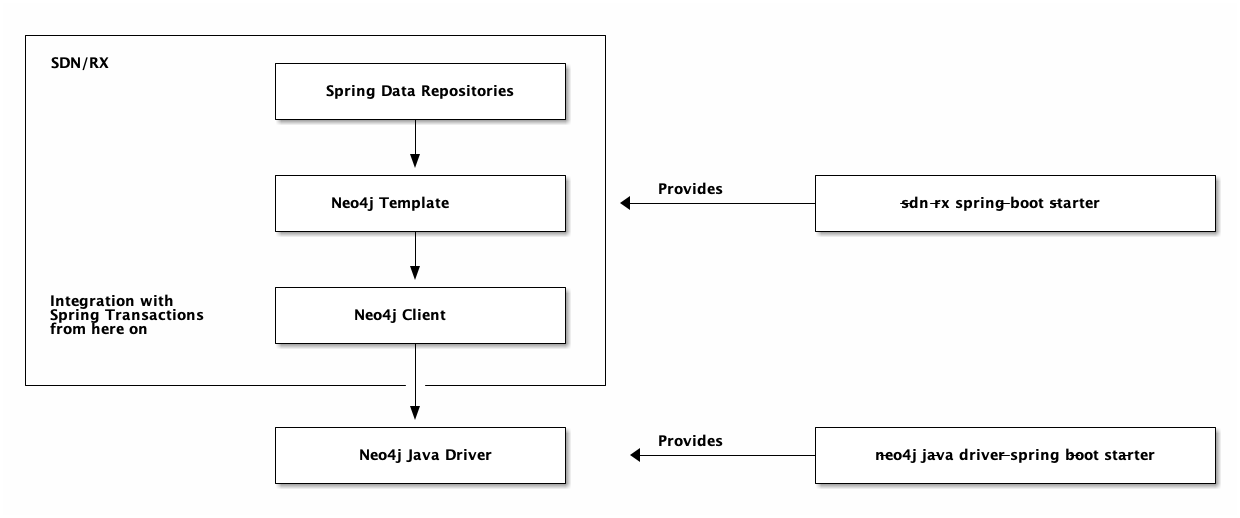Neo4j is a highly scalable, native graph database. Spring Data supports Spring Neo4J for Graph Database: annotated POJOs, SD-Repositories and Neo4j-Template. Tutorial will guides you how to work with Spring Neo4j. Technologies for Spring Neo4j tutorialII. Structure of Project2. Create Spring Boot project2. Add needed dependencies3. Spring Data Neo4j ⚡️ RX - or in short SDN/RX - is an ongoing effort to create the next generation of Spring Data Neo4j, with full reactive support and lightweight mapping. SDN/RX will work with immutable entities, regardless whether written in Java or Kotlin.
This article is about the spring data for neo4j database. Neo4j is a popular graph database.
Spring Data Neo4j module is there which is support only imperative style and currently, it’s only in support and maintenance.
Prerequisites:-
- Spring Data Neo4j or in short SDN is a next-generation Spring Data module, created and maintained by Neo4j, Inc. In close collaboration with VMware’s Spring Data Team. SDN relies completely on the Neo4j Java Driver, without introducing another 'driver' or 'transport'.
- Please note that Neo4j requires each entity to have a primary key, with a field named id being picked up by default. An alternatively named field could be used by annotating it with @Id @GeneratedValue. Then, we need to create a configuration that will be used to bootstrap Neo4j‘s OGM. For simplicity, let us use an embedded in-memory only.
You head this article that means you at least heard about Neo4j and spring boot. below are the prerequisites
- Neo4j (https://neo4j.com/graphacademy/online-training/introduction-to-neo4j-40/)
- Installation of Neo4j on local or use Neo4j sandbox.
- Knowledge with spring data and spring boot.
- For this example, we are using JDK 11.
If you don’t know anything about the above things then I will recommend you should start exploring these things and come back.
In this example, I am using Neo4j sandbox environment: https://neo4j.com/sandbox/
Advantages of using SDN-Rx:

- It supports both imperative and reactive development.
- Built-in OGM(Object graph mapping) and very lightweight.
- Support immutable entities for both Java and kotlin.
Maven/Gradle Dependencies:-
Right now Spring Data Neo4j Reactive starter is not yet part of the official Spring repositories so we have to add that manually, so it won’t be available in the spring initializer website.
PrePare Database:-
For this article, we are using the Neo4j-standard movie graph database because it’s in small size and it’s available in your sandbox as well as in your local.
use this command to start:
Execute the command and deck is an interactive mode, so its seamless execution. The movie database contains a database such as a movie name, release date, crew, director of movie, a rating is given by different individuals or rating companies. The minimal schema relation could be like this
Create Project:
The best way to start with the spring boot project is start.spring.io. Create a spring boot project.
Do not choose Spring Data Neo4j here, as it will show the legacy generation of Spring Data Neo4j that has only imperative support.
Spring Data Neo4j Dynamic Query
Once your project is ready then add the spring data neo4j Rx dependency in your POM or build.gradle.
Configurations:
You can put here your database-specific configurations.
Domain Entity:
All our configurations are done now let us begin and define the domain entity object. As we stated we are using a movie database so we have to create Movie as a domain entity with few properties.
Spring Reactive Neo4j Rate
Entities are nodes.
In the movie entity, we defined a movie name, tagline, actors, and directors.
@Node annotation marks the given class is the managed node. @Id annotation to have a unique property and then we defined different relationships using @Relationship annotation. In the same way, we have a Person entity that contains two fields.
In these entities, we just defined one-way relation to have demonstrated things simple but you can also define an entity in such a way to fulfill two-way relationships.
Let us create a repository class then.

This is to demonstrate the reactive programming style so we used here ReactiveNeo4jRepository which is reactive repository implementation.
You can hit below endpoints to see the output:
GET http://localhost:8080/movies
DELETE http://localhost:8080/movies/The Matrix
This is it for now.